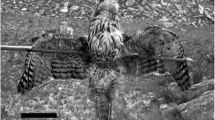Abstract
Recent studies have shown that large fuel loads in small birds impair flying ability. This is the first study to show how migratory fuel load affects flying ability, such as velocity and height gained at take-off in a predator escape situation, in a medium-distance migrant, and whether they adjust their take-off according to predator attack angle. First-year robins (Erithacus rubecula) were subjected to simulated attacks from a model merlin (Falco columbarius), and take-off velocity and angle were analysed. Robins with a wing load of 0.19 g cm−2 took off at a 39% lower angle than robins with a wing load of 0.13 g cm−2, while velocity remained unaffected. The robins did not adjust their angle of ascent in accordance with the predator's angle of attack. Since many predators rely on surprise attacks, a difference in flight ability due to varying fuel loads found in migrating robins can be important for birds' chances of survival when actually attacked.
Similar content being viewed by others
Author information
Authors and Affiliations
Additional information
Received: 28 October 1998 / Received in revised form: 12 January 1999 / Accepted: 30 January 1999
Rights and permissions
About this article
Cite this article
Lind, J., Fransson, T., Jakobsson, S. et al. Reduced take-off ability in robins (Erithacus rubecula) due to migratory fuel load. Behav Ecol Sociobiol 46, 65–70 (1999). https://doi.org/10.1007/s002650050593
Issue Date:
DOI: https://doi.org/10.1007/s002650050593




